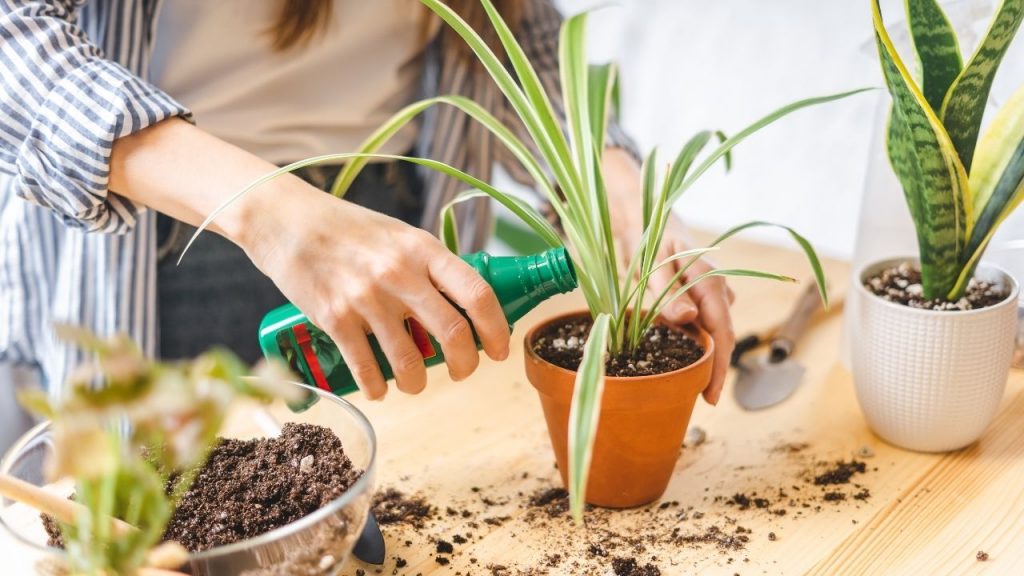11 Plant Tips for Preparing For Spring
It is finally here! You finally made it through winter with your plants! Now what? What can you do to prepare for the growing season, warmer temperatures, and extra sunshine? Here is a list of 11 things you can do today to get started!
Fertilize:

As plants begin to push out new growth they will need more vitamins and nutrients and it is a great time to begin fertilizing your plants if you have been fertilizing all winter due to continuous new growth perhaps consider a slight increase as your plant is now larger and with an increase in sunlight and likely will need more as the season progresses depending on your fertilization method.
Adjust lighting:

As we enter farther into spring the sunlight will become more intense. This means that some light-sensitive plants (like Calathea, Ferns, and Peperomia) may need to be pulled back from windows and out of such intense light. Also, light-loving plants (like Hoya, Tradescantia. And Succulents) may benefit from being moved out of the darker lighted situations or out from under grow lights and into that direct strong sunlight.
Adjust watering:

Springtime means changes and our plant watering needs are no exception. Keep a close eye on your plants and check them frequently. More sunshine and more growth may mean your plants use up more water and dry out more quickly. On the other hand, turning off humidity reduces heaters and opening windows may increase humidity. Higher humidity would allow plants to hold on to more water longer so your watering frequency may need to be reduced instead of increased. This depends on each specific home, room, and specific plant. Feel your plants as these changes come to determine their needs.
Acclimation

You may also be considering moving your plants outside or opening windows next to your plants. This is perfectly fine and most plants will love it. Plants can go into shock if not acclimated to the new conditions. Slowly ease plants into more direct sun. Slowly reduce temperatures. Put plants outside with a protective greenhouse cover and slowly take it off over several days. These are all examples of how to acclimate your plants depending on the plant and its needs. If a plant is not acclimated properly it can go into shock and shed foliage or be damaged by the cold or heat.
Pest Prevention

Another way your plants can be damaged is through pests. Various plant pests will eat and damage your plant. If you start your pest prevention treatments before the new growth comes in too quickly you will be able to see any pests beforehand and know how to best treat them. Pests get away with a lot of damage because they are tiny and not easily seen. If you already have your prevention method in place it will keep this from being a problem. Whether you use insecticides or beneficial bugs the best time to prevent pests is before they decimate your plant.
Repotting

With all this new growth it is important to remember that it is not just the foliage of your plant growing but the roots as well. Your Plant could be root bound or need a soil refresh. The plant generally need a repot every 6 months-2years depending on the plant’s growth and nutritional needs. If your plant’s pot is full of roots and it is not a plant that enjoys being root-bound consider giving it a report before the start of the growing season.
Spring cleaning

After repotting some plants you may start to notice a few things left from winter that need to be cleaned. Cleaning saucers and dirty plantless pots. Old leaves that need to be removed. Shelves can be wiped down and windows can be cleaned. Spring cleaning the plant area can help prevent pests and give your plants a safe clean place to grow.
Shape Your Plant

While cleaning you may notice some of your plants are not growing how you want or have some overgrowth. Before the big spring, growing season comes now is the time to trim some of those plants. You can use a method called purposeful pruning where you trim your plants in a specific way to promote new growth from specific areas so your plant grows how you want it to.
Propagate

Now that you have trimmed up your plants you can propagate the cuttings from them and grow whole new plants. Depending on the plant you can propagate from a leaf, a stem, a rhizome, or a branch. This is a great inexpensive way to acquire new plants.
Stock up on supplies

With these new plants, you may need more supplies and springtime is when they are stocked the most. Now is the time to buy any new plant supplies or restock. If you need more soil or perlite or that big nursery pot you have been staring at, take advantage of the spring sales and get what you need while it’s still in stock. You can also stop by the nursery and see all the new plants! A lot of nurseries carry plants all season but become overstocked in the spring and you can find plants you had been searching for.
Plant Wishlist

Before buying all the new plants, keep in mind that it can be easy to buy too many at once and become overwhelmed or to see all the pretty foliage and spend our entire budget on plants. A way to prevent this before you go plant buying is buying make a list of your wish list plants or plants you hope to get this year. Then you can have a sort of guideline to stay in and a goal for the plant buying season.
From fertilizing, to lighting, to plant shopping there is so much changing and even more to do in Springtime. Which tip will you be implementing today?
Published at Wed, 27 Apr 2022 08:35:15 -0700
